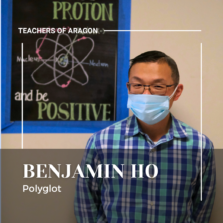
Trending on Twitter. Gaining followers on Tumblr. Social media is designed around the goal of becoming popular. At Aragon, blogs have evolved to serve a more educational purpose.
Blogs were first introduced to Aragon by AP Government teacher Scott Silton. Silton’s idea was to create a forum for his class to discuss current events outside the classroom. Originally, Silton took everyone’s email and formed a listserv, which is a way of forming mass email chains for discussions, but this was more cumbersome than necessary once Silton learned of user-friendly hosts like blogger.com.
“I want my students to get both an academic textbook and a civic education. There are all kinds of Gov and Econ that show up in the news, and current events can reinforce [what’s being taught in class],” says Silton. Students choose a week to make posts on the blog and comment on other students’ posts throughout the year in order to get points for their grade.
Some raise concerns that a point-for-comment sytem encourages students to emphasize quantity over quality of comments in order to improve their blogging grade. Silton, however, believes that there has to be a grade involved with the blog. Explains Silton, “It’s hard to get students to see the value in reading something they won’t be tested on in the next week. [Commenting] should be seen as easy points. Superficial point getting does happen when students just agree, but grading [the blog] monthly lets me see the whole picture.”
Junior AP U.S. History teacher William Colglazier just started using a blog with his history classes this year after attending a tech conference that suggested new teaching techniques. Like Silton, Colglazier thought that there weren’t enough current events being covered in class, which inspired him to start using a blog. Says Colglazier, “I thought this was a great way for students to engage in current events with each other rather than engaging with the teacher.”
An issue many students have noticed with Colglazier’s blog is a lack of discourse—students’ comments tend to agree with the ones above them to an extensive level. There has indeed been a large amount of passive agreement on Colglazier’s blog, as students just try to get points. Explains Colglazier, “If you put [the students] in a room, there’d be a level of agreement and of disagreement.” Still, Colglazier believes the blog accomplishes its purpose. States Colglazier, “I think that more students are more aware of current events.”
English teacher Victoria Daniel also uses a blog to teach students, but has a different way of dealing with points. Because she teaches English, she posts questions to her blog for her students to respond to for extra credit. However, Daniel doesn’t just give credit for commenting on the blog. Says Daniel, “It’s not just completion points. [Students] get counted down for spelling.” Daniel’s blog also differs from Silton’s because students don’t post articles, they respond to the prompts she gives them.
Another benefit to the blog is that it gives students an opportunity to speak if they are normally shy during class. But there are problems with commenting from behind a computer—for instance, intense arguments or “flame wars.” Thankfully, the “flame wars” that were common when the blog first started have died out according to Silton. “Maybe it’s the current generation, but our students are more respectful than a Washington Post blog,” says Silton. Colglazier is similarly encouraged. “[I’m] very pleased with the amount of respect on the blog,” he says.
From Silton’s perspective, the blog is successful, as students’ grades don’t hinge on whether or not they comment, while it is still a way of getting more points and learning more about the world. Says Silton, “I do think [the blog] achieves its basic objectives over the long run.”
But how well do the blogs meet their goals from students’ perspectives? Junior Edgar Tenorio agrees that the blog helps them learn about current events. Says Tenorio, “I learn [about] some of the current events I hadn’t noticed.” Junior Alex Garcialuna agrees, saying, “It’s important for us to know what’s happening in the world.” But while many agree that the goal of the blog is met, a good length for commenting is yet to be set. Says senior Aaron Yen, “Three to five sentences is a good comment. But some kids post whole essays, and I’m like, ‘No, I’m not reading that.’” Junior Liam Richardson adds, “A comment is too long when they try to state all the background information.”
So while the blog does achieve its goal, how long a comment should be is still under debate. Silton himself concedes that brevity is not his strong suit, but believes that there is value in getting your point across quickly. Explains Silton, “[In the] original version, there were grotesquely long posts. I use them as a model for what not to do.”
As the trend spreads, the outlook for class blogs seems hopeful. As students warm up to the idea, class blogs are progressively becoming interesting forums for the discussion of current events at Aragon.




